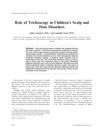Hair Disorders
June 2000
in “
Primary Care
”

TLDR The document explains different hair loss types and treatments, emphasizing diagnosis through examination and tests, and specific treatments for each condition.
The document from 2000 provides an overview of hair disorders, detailing the anatomy, life cycle, causes of hair loss, and treatments for various types of alopecia. It classifies hair loss as generalized or localized and as scarring or nonscarring, with diagnosis beginning with history and physical examination, supplemented by tests like the hair pull or pluck test and laboratory tests as needed. Androgenic alopecia is treated with topical minoxidil and oral finasteride, while female pattern baldness also uses minoxidil. Telogen effluvium, a diffuse hair loss condition, may require serologic tests and blood work for diagnosis. The document also covers alopecia areata, which has a variable prognosis and is treated with steroid injections, trichotillomania, treated with behavioral and pharmacological methods, traction alopecia, preventable through hairstyle changes, and tinea capitis, treated with oral antifungals. Scarring alopecias lead to permanent hair loss and require specific treatments. The importance of focused medical history, examination, and selective laboratory testing in managing hair loss is emphasized.

